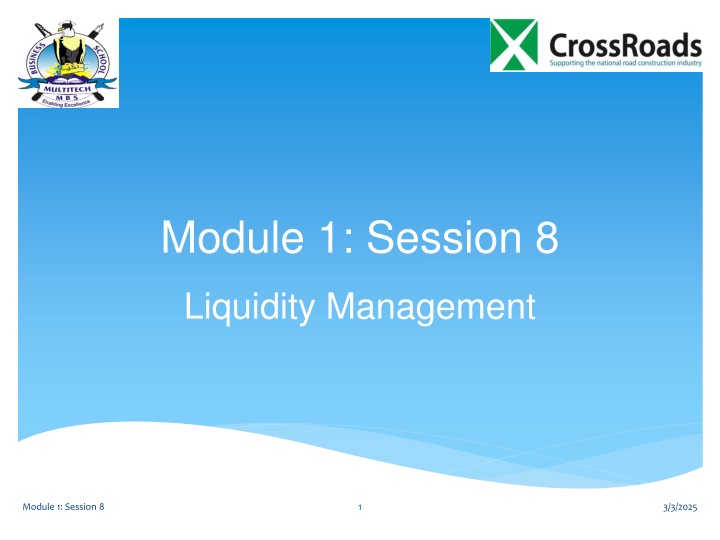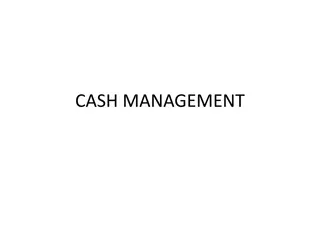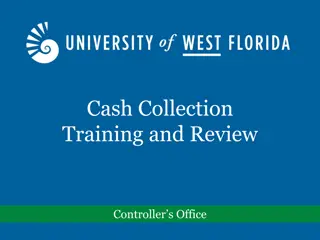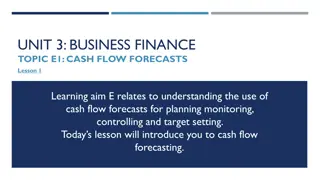Importance of Cash Flow for Business Sustainability
Cash flow management is vital for the health of a business, ensuring efficient operations, timely payments, and sustainable growth. Learn about the significance of cash flow, its impact on profitability, and strategies to enhance liquidity in this informative module.
Download Presentation

Please find below an Image/Link to download the presentation.
The content on the website is provided AS IS for your information and personal use only. It may not be sold, licensed, or shared on other websites without obtaining consent from the author.If you encounter any issues during the download, it is possible that the publisher has removed the file from their server.
You are allowed to download the files provided on this website for personal or commercial use, subject to the condition that they are used lawfully. All files are the property of their respective owners.
The content on the website is provided AS IS for your information and personal use only. It may not be sold, licensed, or shared on other websites without obtaining consent from the author.
E N D
Presentation Transcript
Module 1: Session 8 Liquidity Management Module 1: Session 8 1 3/3/2025
Purpose of Session Outline the importance of cash flow in business Relating profits to cash Introducing the funds flow statement Causes of cash flow constraints Indicators and consequences of liquidity problems Techniques to improve cash flow Module 1: Session 8 2 3/3/2025
Importance of cash flow to a business Cash to a business is what blood is to a person. Cash is required to obtain materials, tools, equipment and services that go into doing a contract. It can be disastrous for a business to run out of cash as it risks work stoppage and desperate measures. There is a time lag between spending cash on the project and receiving payment from the client (the cash cycle). Module 1: Session 8 3 3/3/2025
The Cash Cycle With government contracts this period can be unpredictable. When dealing with private sector there is even the risk of non payment. The longer the period the more the cash required to run the business. The lower the credit obtained from suppliers the more the cash required to run the business. Module 1: Session 8 4 3/3/2025
Relating profits to cash Profits are not tangible until turned to cash. The impact of losses is not felt until cash turnout! There is a timing difference between recognition of revenue and when it turns into cash e.g. invoicing a client and getting paid takes time. There is a timing difference between recognition of expenses and when cash is paid out e.g. purchase of an excavator and depreciating it. A cash flow statement removes the timing differences and brings out cash changes over a period of time. It answers the common question of where did the profits go? Module 1: Session 8 5 3/3/2025
Cash flow statement The cash flow explains the changes that have taken place between one date and another and how the change have occurred. It explains how trading and other financial decisions affected the cash position of the business during a period. A business will increase cash when capital is injected, takes on loans and advances or disposes off some of its fixed asset or when its clients pay. A business will reduce its cash if it pays off its suppliers, pays out dividends, reduces its borrowing, lends out money or acquires fixed assets. Module 1: Session 8 6 3/3/2025
Example of simple cash flow statement Funds Flow Statement Profit Increase in accounts receivable Increase in inventories Increase in accounts payable Investment in fixed assets Outflow of cash 30 -25 -10 2 -10 -13 Bank balance at start of year Bank overdraft at end of year Change in cash position 5 8 -13 Module 1: Session 8 7 3/3/2025
Golden rule to cash management Make prudent decisions to maintain liquidity in the short term and increase cash over the long term. Increase the rate of inflow of cash and minimize the rate of outflow of cash. Invest in ventures that that will return it with larger margins as quickly as possible. Match long term cash investment with long term financing. The cash flow statement tells us how the business is addressing those principles. Module 1: Session 8 8 3/3/2025
Causes of cash constraints Acquisition of or investment in fixed assets Withdrawal of cash for non business related items Having inadequate trading credit Paying off loans and short term credits Delayed incoming payments Increasing inventory levels (and work in progress) High operating costs, and high interest rates Low trading margins Overtrading Module 1: Session 8 9 3/3/2025
Indicators of liquidity problems Delay to meet suppliers payments when due Failure to settle essential obligations Poor liquidity ratios Quick ratio Current ratios Defaulting on loans and suppliers obligations Failure to take advantage of special offers Stock outs of key ingredients Bouncing cheques Module 1: Session 8 10 3/3/2025
Consequences of liquidity problems Delay in execution of work Expensive procurements Low morale amongst staff Withholding of services and supplies Risk of unethical practices Loss of business Reduced profitability Recall of loans, litigations etc. Failure to take advantage of lucrative business offers. Module 1: Session 8 11 3/3/2025
Techniques to improve liquidity Negotiate for suppliers credit Obtain advance payments Avoid or restrict allowing credit (credit vet) Factor the cost of delayed payment into price Where possible, negotiate early payment discounts Provide for interest charges on delayed payments when contracting Module 1: Session 8 12 3/3/2025
Techniques to improve liquidity Have standby facilities e.g. overdraft Maintain a healthy minimum cash reserve Avoid clients with poor paying reputation Seek appropriate financing for fixed assets investment Avoid non profitable assignments Module 1: Session 8 13 3/3/2025
Group assignments 1) What is the importance of liquidity to a road contractor. 2) Can a profitable business have liquidity problems? Indicate possible causes of liquidity constraints to such a business. 3) Can a non profitable business have good liquidity? Identify how such a business would maintain liquidity. 4) Advise Munaku on how he could improve the liquidity of his business. 5) Identify symptoms of cash shortage and the consequences to a road construction business. Module 1: Session 8 14 3/3/2025























